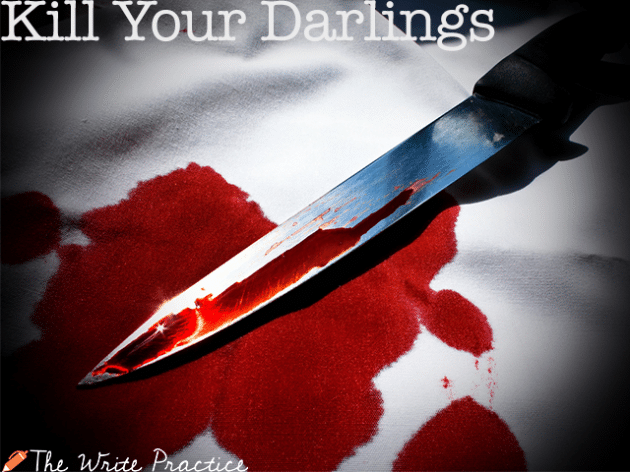When writing a series (or even just a really long novel), at some point, the characters become known, their dynamics set, and readers can almost guess how characters will feel about a given plot twist before it happens. Fans go beyond love for characters and form deep connections… and expectations.
Some readers love to simply love their characters and enjoy their next adventure. But don’t discount the fun of “killing your darlings” to shake things up.

“Kill your darlings, kill your darlings, even when it breaks your egocentric little scribbler’s heart, kill your darlings.” —Stephen King
Yes, that’s right, kill them. Both Joss Whedon and George R. R. Martin have reputations for breaking their fans’ hearts by killing off key characters who should have been “safe.” But while fans are heartbroken, they also can’t seem to look away at the train wreck that ensues after these tragedies.
And your stories can earn this undivided attention too, if you’re gutsy enough. You may even find yourself enjoying the freedom of all this creative freedom.
Here’s how to do it:
Don’t kill your darlings without purpose
This is the first rule of the Darlings Kill Club. Chaotic action is just chaos, tearing yourself and your fans apart for no reason. When looking to shake things up, look for the things that will force other characters to do things they never would have before, expose new aspects of themselves, or otherwise change the core dynamics in your story.
Identify established patterns
A problem with long-running series is that their behavior patterns within the dynamics of your story become too familiar. Who can always be counted on to behave a certain way, or handle certain problems? What challenges would removing that reliability present to your other characters?
Off the fan favorite
This may seem particularly cruel—or even risky, if you fear fan backlash. But if you understand not only who the fan favorites are in your story but why, stirring the pot can create a great emotional hook and big-time drama in your story, because as your readers struggle to cope, so do your other characters. How will they get through it? Who will step in to fill the void?
Fans may love the dependability of your victim, but that dependability also keeps your story predictable. And predictable just isn’t as much fun as unpredictable.
… Or the author favorite
Or put otherwise, who do you think this story absolutely could not exist without? Go ahead, imagine what happens if that character disappears. Sometimes the loss of the central character is exactly what your story needs to refresh and shift into a new gear. Keeping the story tied to your own darling may actually be holding you back.
Some of the most devastating and compelling moments in stories come when a character is unexpectedly lost. At first, killing our darlings is hard because we love our work by necessity, and we bring assumptions with us into it. But once you start looking beyond your feelings and consider the possibilities, you may be surprised to find you’ve opened up an entirely new world of options.
Can your story benefit from killing your darlings?
PRACTICE
Take fifteen minutes and consider your work in progress—what happens if you get rid of a central character? Brainstorm how this could develop the plot in new ways, and share in the comments!







I had such a hard time ‘ending’ my story that I killed my hero. All ten fans of my fan club, hated me for it but at the time of writing, I figured if George could do it, then so could I. It worked for me but three of those fans are looking for the next book. I didn’t count on that…now, to bring the minor character to main status and write the second book of an unplanned series.
Sometimes that kind of fan anger can be a backhanded compliment … they loved your character THAT much! Have fun exploring your story’s minor characters.
Christine, like you, I found myself in hard times when I have to kill some of my characters (even the bad ones, shame on me!) but George RR Martin it is very good explaining how he kill them, and of course, why we care so much about their luck.
Well, the answer is “consequences”. In “Game of Thrones” you see characters being kill because of a stupid or a pride decision that they take,
Since I read that, I find less hard to kill my characters.
I hope it helps you!
I believe Stephen King was quoting William Faulkner: “In writing you must kill your darlings.” He was referring to a writer editing out her favourite words and phrases. And especially little gems of sentences. I guess we writers get overly attached to our little flares of brilliance, which might not exactly suit the context in which they’re used. Now I’m reminding myself to pore through my work-in-progress and kill off a few darlings. Ouch!
Yes, the phrase “kill your darlings” has been used to refer to a lot of different things in writing … and they can all be difficult to actually do!
I do like the article and your tips are good Emily so this post is not intended to be criticism. It is such a wonderful little quote that I thought it would be good to share all the other meanings it can have so as to deepen the wisdom and the utility of your post.
I can also see how killing darlings can be interpreted as killing of characters specially when the quote is isolated out of context but I agree with P J Reece above.
Maybe reading the entire book “On Writing” by Stephen King allows a fuller interpretation of what he originally meant to convey. Here is one explanation of the misunderstanding http://www.iouart.co/2013/10/kill-your-darlings-real-meaning-and.html
Thanks, Henna… I had a feeling that the quote went back even farther than Faulkner, so thanks for letting us know it was Arthur Quiller-Couch.
If you don’t want to go so far as to actually kill your protagonist (which could be difficult if you’re writing from a first person POV), you could always “kill” him psychologically. In other words, make him go through a traumatic experience which shakes him to the core and causes him to start behaving in a totally different way than before. This could be a temporary reevaluation of life and priorities, or it could become a lifetime struggle, such as with PTSD. As the protagonist develops new, unreliable behavior, both the support characters and the readers will experience tension. Then you can choose whether to work the protagonist back around to “normal” behavior – which could provide fascinating plot material – or you can let your protagonist keep his new personality traits and have to learn to function in his old world again while playing a different role. Either way, the support characters will have to learn to cope with him being “the same, only different,” as will the readers, and your story will have a fresh perspective.
Absolutely — what would your character consider even worse than death?
Potential options would be the death of a best friend or loved one (which could be “killing a darling” depending on the character’s role in the story), losing previous physical abilities (e.g., a soccer player permanently injuring his leg), or losing his confidence through a tragedy he has caused or through injury from others. Any situation where the character loses something he considers vital for living.
My WIP involves a character who normally is fun-loving, mischievous, and somewhat rebellious. After undergoing a severe trauma, he shuts down emotionally and becomes apathetic, no longer having a zest for life but simply working through the routine every day. He is only able to break out of this state when the life of someone he loves is at stake and he decides to risk himself to save her. In the end he is able to mostly return to his former personality (except for having matured some), but the interval where he is almost a different person creates some tension and interest since it explores what happens beyond the character’s expected norm.
I like your idea! It is something like Freud explained as “castration”. When people loose what they think it’s their strenght, there is a tendency to become mad.
Very nice Grey! That would indeed make the story either really intense or have it resolve to some degree. I really like it. Thanks for sharing!
This is pretty hilarious, and prefect with its timing. This is actually the premise of the sequel to my next novel. A character important to my lead is killed, unleashing his super-powered evil side. For reference: http://tvtropes.org/pmwiki/pmwiki.php/Main/SuperpoweredEvilSide
Oooo like Willow in Buffy 🙂 Sounds like fun.
Kinda, but in comparison to the DarkWalker, Willow was a piker. 🙂
I like.
If you’d like to follow the rest of the story, you can check out my blog. It’s attached to my Disqus account. I’d post a link here, but Jeff might think it rude of me to do so without permission.
Oooo very intriguing R.s. Foster! I can’t wait to see this in action!
I’m now working in a mystery / terror short story about a traveler who get lost in the jungle and he finds a beautiful town.
He enters looking for somebody to help him to return to the right track, but he only find 13 letters of the former inhabitants. Each of these testimonies reveal one part of this mysterious town and how they escape from it.
After reading this, I’m seriously thinking about our traverler to get kill by one of the 13 menances of town… or even better: 14 different finals: 13 getting kill by each menace of town and an alternative one, he survives.
What do you think? Any comment is very welcome.
Cheers!
This sounds intriguing, Teo! I think the best answer for your story probably comes down to how each of these endings changes the thematic meaning of the work, and which one feels right for your vision. Good luck!
Thanks for your opinion, Emily! It is really helpfull for a better development of the story. I will let you know, which one I use! Cheers!
Indeed as Emily said. This is intriguing Teo! Its the type of story that I would imagine sends chills down the spine. I wish you good luck. I very much like this story idea.
Miriam, I’m gladd you enjoy this preview and I hope to share it when I have it done.
By now, I’m writing it in Spanish, then I will translate it, to share it through here.
Thanks for the feedback! Cheers!
I’ll be glad to see it when its done 🙂 (did you see the guest blog post I did on the write practice last week on the 22nd? Its called “How One Writer Destroyed Self-Doubt,”)
I will look it right away!
🙂 Its like the first thing I’ve ever gotten published on.
Miriam, thanks for sharing your traumatic experience and let us know how you succesfully overcome it.
I just left a comment in the article. I’m looking forward to read more about you here.
Cheers!
That sounds like a great idea!(For some reason I immediately thought this would be a great videogame, go figure :3)
Thanks, Pedro! In fact it is inspired in an old school videogame for PC titled “Quest For Glory V”, that’s why smells like a game narrative 😉
I remember coming to terms with the idea killing characters after watching Attack on Titan. It was specifically at a point where the one character I like out of four people were killed. Right after that, seeing how the leader of that squad just looked at the dead, dismembered bodies of his comrades just resonated with me this pain he needed to unleash on the killer.
With my first book I’m currently working (the word count probably adding up to about three book series, go figure), I’m trying to see how the death of one character will destroy another. After reading this, it got me thinking if so and so, how would my cast of characters would react to it.
Definitely something for me to keep in mind when I’m thinking of events that’ll keep the plot moving.
Yes Attack on Titan does tend to kill a lot of characters. Sometimes you just have to kill a character to continue on your way.
In my grand fantasy where I become the next Agatha Christie and write best selling mystery novels till I’m old and senile, the series my WIP is planned to be the beginning for (A&A Mysteries) will follow the main characters from now – when they’re 14 – to when they’re adults, possibly senior citizens. And over that much time, close friends and family will slowly die off. I don’t plan on killing my main characters though. They get close a few times, but after a life of catching killers they’ll get a nice, peaceful ending.
Hey everyone. I laughed at this Emily. Recently I’d just came to the conclusion that I’d have to kill one of my characters. I can totally relate to this. Here is my pracitice I hope you like it.
There it stood with finality, the gravestone of Garret my lover. How could they do this? How could they have taken him from me just like that? Didn’t they care that they hurt me?
The answer was simple to all these questions, they didn’t care. In fact they probably took pride in my misery not knowing how much he meant to me. I cursed myself for not seeing it sooner. He loved me and I only truly realized it when he was taken from me.
My friends spoke condolences as they left having paid their respects. They were meaningless empty. How could they know how i felt? It was impossible. No one could help me, no one knew how i felt.
The tears burned my checks but i let them come. Garrett deserved them, he deserved to know how much I loved him.
Footsteps approached from behind but I ignored them. A hand was placed on my shoulders in a counseling way.
“There is nothing you could have done to prevent it.” came William’s, my father’s, voice. “It will do you no good to blame yourself for what happened.”
“And how would you know,” I spat furry coming suddenly. He couldn’t know how I felt.
“Because I lost my wife in the same way. She died to save my life a day I’ll never forget.” I turned to look him in the face. To my surprise I saw tears there. The father i knew never cried and yet here he was tears slipping down his Military face.
I turned away. I hadn’t meant to provoke tears. The graved laughed at me as though mocking me.
“Come we’re all worried about you. I’ll get you something nice to eat.” I was lead away, walking as though weights had been put on my shoulders. My eyes remained fixed on the grave.
They would pay for taking my love away, oh yes they would pay.
Great piece, Miriam! I can imagine the beggining of an exciting revenge story, am I right? Keep it going!
Thanks for the comment Teo. Exciting is how to write a revenge story. Happy writing!
As I developed the idea for my current work in progress I told my best friend all about it. One day I just about knocked her over when I told her I was going to kill a little girl in the story the day of the main characters prom and have one of the two guys who wanted to take her to prom get into a car accident around the same time. It is freeing and empowering to know how much it effects readers. My friend told me that by killing that character and almost killing another around the same time would kill my readers!
Indeed sometimes we need to kill a darling. I’m planning on killing at least two, if not more in my WIP.
I am revamping my WIP, too many subplots and tangents. In paring down, I’ve killed off many, many little darlings (although in future they may rise from the dead to appear in their own stories). After thinking about this practice, I have made a difficult decision. I must kill off a character I love. I have known for a while I needed an apocalyptic event to get my main character out of her introverted, retiring self, and take the definitive action that creates the dilemma central to the story. I have tried to weasel out of killing her friend, but every alternate “significant” event seems contrived and not reprehensible enough to metamorphasize a nerdy scientist into a woman who decides to save humanity.
The doomed character is Lorelei, a junior scientist, and assistant to Dr. Donnie. Dr. Lorelei Gold will be a breath of fresh air in Dr. Donnie’s life. The relationship will begin as a traditional mentor/mentee arrangement, with Dr. Donnie supposedly mentoring Lorelei in the most advanced computer programming and mechanical engineering. What emerges is a relationship in which Lorelei actually mentors the older woman in how to have a life. Lorelei introduces her to jazz, takes her on a wild off-road trip, and amazes her with an ability to connect to nearly everyone around her, and to make time to hear their hopes, dreams, and concerns. She is faithful to her fiance, and takes care of her aging parents. My God, she is a saint. And that is why she must die.
I have quite a horrible death planned for her, poor thing, at the hands of Tonias Black and Sasha Small. It is going to be really hard to write, and I have truly fought admitting this had to be done. After today, I know I need to get it over with.
And then I have to deal with how upset Dr. Donnie will be. I also have not wanted to deal with the repercussions of this act. As you can see, I care a lot about these characters, and can’t stand for them to be upset for even five minutes.
This author thing is very demanding. Is this why writers drink? Geez….
Yes I remember going through this same thing when I came to a similar conclusion. There was no way I could get my main character into action until I made the fight real for her. I had to make her see that this wasn’t’ a game and that she was now expected to step up her game. Thanks for commenting Avril
That is a great idea Avril, that idea of holding onto the darlings you must kill from one work to use them in a different story later.
Killing your darlings is not only a lot of heartache, it’s also a lot of work, because it means totally shifting dynamics. But if it hurts, that means you have probably created a really good character (or you are just too lazy to deal with all of the additional work, haha).
Killing protagonists and favorites is especially effective in TV shows, where the audience has known them for a long time – for too long maybe, and it’s time to shock the audience and subsequently introduce one or several new elements/situations. A lot of new toys to play with for the screenwriters. So the move essentially is useful in two ways.
While reading the article, I had to think of “Dexter” and “Breaking Bad”, but maybe that’s only because these are the only two shows I have watched recently. The “Gus Frings” character has a pretty prominent role in “Breaking Bad”, but I also think that this character doesn’t work at all and once they kill him, the show becomes a lot better again. Of course, when they shoot Hank a couple of episodes before the end, that’s a big shocker too, because it’s unexpected. Had they shot him in the last episode, it wouldn’t have been half as exciting, because it would have been a lot more predictable (selling out of characters, just moments before the shop closes).
(Spoiler alert) … thanks Alex!
My main character die halfway through the story. He is portrayed as someone quiet, but deep inside he want things that somehow he cannot achieve. In a attempt of get a great amount of knowledge he die, this make other girl the main. It´s all about metaphor; the first one carry the death, ambitious, envy, ego, and despair, the second arc is about hope, patience, love, and the simple things in life, something carried by the female new leader.
Sorry for the mistakes, english is not my native language 🙂
Your post has been plagiarised. That is, it has been republished as is, with no attribution given to you as the primary author. This is the address of the plagiarised post.
https://amirhoseinghazi.wordpress.com/2015/12/12/kill-your-darlings/
This is the software I used. http://smallseotools.com/plagiarism-checker/
I hope that this notification has been helpful.